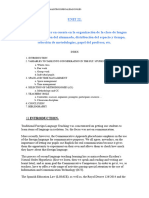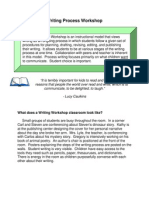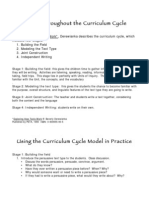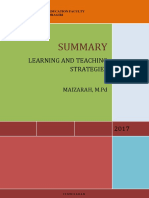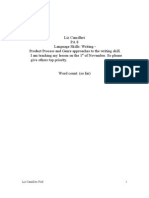The Basics of Writing Instruction
Uploaded by
Anderson AlvesThe Basics of Writing Instruction
Uploaded by
Anderson AlvesProcess of Writing - 1
HELPING STUDENTS DEVELOP THE ABILITY TO USE WRITING TO EXPRESS
THEIR IDEAS
Andrew P. Johnson, Ph.D.
Minnesota State University, Mankato
Let us be clear about one thing: You are not teaching students how to write. In most
cases they already know how to do this. The problem is, for a variety of reasons, many students
are not very good at it. Below are described two ideas that can be used to help develop their
ability to use writing to express their ideas. Below are described (a) the 5-step writing process
and (b) writing workshop
THE 5-STEP WRITING PROCESS
The five-step process writing approach is presented here. Most of the writing activities
you do with students will involve just Steps 1, 2, and 5. But in teaching writing, at all levels, you
must teach the process of writing.
Step 1 - Pre-writing. The goal here is to generate ideas. Listing, brainstorming,
outlining, silence, conversation with a neighbor, or power writing, all are ways to generate ideas.
Step 2 - Drafting. Drafting is the writers first attempt to capture ideas on paper.
Quantity is valued over quality. If done correctly, the draft is a rambling, disconnect
accumulation of ideas. Most of the writing activities in the classroom involve just these first two
steps along with sharing (see below). Only those hot topics or those drafts that students feel are
interesting or of value should be taken to the next step. In this way, students are making choices
about their writing topics and given a sense of autonomy about what they will say and how they
will say it. All drafts should be put students portfolio or file folder at the end of the writing
session.
Step 3 - Revising. This is the heart of the writing process. Here a piece is revised and
reshaped many times. The draft stage is like throwing a large blob of clay on the potters wheel.
Revising is where you shape the blob, adding parts, taking parts away, and continually molding
and changing. Here you look for flow and structure. Writers spend a lot of time re-reading
paragraphs and moving things around. Again, not every story draft should be taken to this stage.
Students should be given a choice as to which of these drafts they want to take to the revision
step. Generally, students find only about one in five drafts worthy of investing the mental and
emotional energy necessary to revise and create a finished product. The rest of the story drafts
can be kept in a file folder as a junkyard for other writing ideas or included in a portfolio to
document students writing journey.
Step 4 - Editing. This is the stage where the mechanics of writing are attended to. This
is where grammar, spelling, and punctuation errors are corrected. Many writing ideas have been
ruined by teachers who insist that Step 4 be Step 1 or Step 2. If writers are editing or worrying
about mechanics at the pre-writing, drafting, and revising stages, the flow of ideas and the
quality of writing will suffer. Precious brain space that is devoted to generating and connecting
ideas will instead be utilized to worry about writing mechanics. Writing is learning how to
create and communicate meaning. When the mechanics of writing are seen as a means to more
clearly communicate an idea, they are more readily learned.
One last thing about the editing phase: Real writers edit their writing at the end. Real
writers also rely on editors, spell check, and grammar check. In teaching your students to
become authors and composers of authentic writing, teach them to approximate the writing
Andrew P. Johnson, Ph.D. -- DRAFT
Process of Writing - 2
process used by real writers. That is, set up peer editing groups and teach students how to use
the grammar and spelling functions on a word processor.
Step 5 - Publish or Share. This is where students writing is shared with an audience.
Writing becomes real at this point. Publishing can involve putting together class books,
collections of writing, school or class newspapers, school or class magazines, or displaying short
samples of writing in the hall or out in the community. Writing experiences become even more
powerful by having students read their work out loud in small groups, to another class mate, or in
a large group setting.
WRITING WORKSHOP
Writing workshop is structure created in a general education or special education
resource room whereby all children are writing using their own writing topics. It is like a
carpenters workshop in that students have varying writing projects at various stages (pre-
writing, draft, revise, edit, or sharing) all going on at the same time. Writing workshop is the
ideal multi-level strategy to use in an inclusive classroom setting because students are able to be
successful in writing and thinking at their level.
Writing workshop looks different in every classroom. It contains some or all of the
following elements in varying orders and degree.
1. Mini-Lesson (5-8 minutes). This is usually done at or near the beginning of the
workshop. Here the teacher provides a brief lesson to the whole class on some aspect of writing.
This lesson could be related to grammar, punctuation, spelling, or one of the steps in the writing
process. How do you know what to teacher here? There are two sources. The first source is to
use the set of standards, the language arts curriculum, or the designated scope and sequence
assigned to your grade level. The second (and the best) source for skills mini-lessons is to look
at students writing or observe them writing and see what skills are in need of teaching. The
mini-less should be relatively brief. Remember, nobody learns a skill from one exposure. It is
expect that you will need to review skills throughout the year.
Mini-lesson can also be conducted in small flexible groups. This type of lesson is used to
focus on a specific skill. For example, if you noticed three students struggling with the concept
of a sentence, you might call just those three students up to the table for a short mini-lesson.
2. State-of-the-Class (5 minutes). This is one way to keep track of students progress.
At the beginning of class you simply call on students and ask them what they will be working
that day (see Figure 1). There are two variations of this. First, for older students you could have
some sort of sign-up sheet (either posted or passed around on a clipboard), where students record
the information below. The second is to walk around and observe or ask students as they are
writing.
Figure 1. State of the class sheet.
Student Topic - Title Date Stage
Billy P. Dog story 4/17 2
Sally M. Poem - school 4/17 3
Dick S dragon 4/17 1
Jane T. Grandmas cookies 4/17 5
Key 1 = Pre-write, 2 = draft, 3 = revise, 4 = edit, 5 publish
3. Sustained Silent Writing (10 minutes). At or near the beginning you may wish to
include sustained silent writing time or a bubble of silence where everybody (including the
Andrew P. Johnson, Ph.D. -- DRAFT
Process of Writing - 3
teacher) is writing. Yes, a teacher should be writing and sharing with students. There should be
no talking here. Instead, students and teachers are thinking, planning, drafting, or revising.
4. Sacred Writing Time (15-40 minutes). This is at the heart of the writing workshop.
It is called sacred writing time because it should happen every day. It should very rarely get
bumped. If students know they are going to be asked to write every day, they begin thinking of
writing topics outside of class.
In sacred writing time students might go through their folder or portfolio and select a
draft to beginning revising. They may also revise, edit, get feedback, or share. This is the time
when students have individual conferences with the teacher.
5. Conferences (3 -20 minutes). Here the student and the teacher meet to talk about
writing. This is not an editing session; although the teacher may give tips on what to include.
Here the teacher usually asks about the status of students current work, what kinds of things that
may cause them to struggle, and future writing topics. Here the teacher might also note possible
skills for future lessons.
6. Sharing (5-8 minutes). Sharing with other students is what makes writing come alive.
Described in Figure 2 are four ways students can share their writing with others:
Figure 2. For strategies for sharing students writing.
1. Partner oral response. With this is the type of sharing students find a neighbor and read a
part or all of that days writing. If students do not want to read their work, they can simple orally
describe some of the main ideas. You will have to teach students how to respond to the work
of others. A poster containing guidelines below can be used to begin this process.
Response guidelines.
1. What did you like?
2. What did you want to know more about?
3. What might be added to make it more
interesting?
4. What did it remind you of?
2. Small group oral response. In small group, students can read or describe some of all of
that days work. These entries become natural vehicles for small group discussions as
members of the group respond orally with aesthetic response questions and comments.
3. Trade and respond. Students can trade papers (or computer documents) with a partner
invite that partner to write ideas on page or on a separate page. This way the writing
becomes a living entity and a collection of perspectives. If done in groups of three or more,
students can keep rotating the writing until everybody has responded to each.
4. Whole class. Two or three volunteers can sign up to share a completed with the class.
Teachers should never do more than three of these whole-class kinds of sharing in a given
class period as students naturally get distracted after a few minutes of listening passively.
Three Big Ideas for Writing Workshop
1. Student choice is essential. They should be able to choose their own writing topics.
They should be able to look through their folder and choose which draft they want to take to the
revision stage. They should be able to choose the length of their writing. And they should be
able to abandon a piece of writing if it turns cold on them.
Andrew P. Johnson, Ph.D. -- DRAFT
Process of Writing - 4
2. Students need to write something every day. It need not be long, but they must write.
3. Students need responses more than corrections or edits. Tell students which parts you
liked, what it made you think of, what parts were confusing, and things you might include, then
you can talk about one or two mechanical elements.
PRE-WRITING SKILLS
Students may have difficulty generating ideas for writing. The strategies below are
sometimes referred interventions for generating ideas. Here, you simple teach students to use
one or more of the pre-writing skills in Figure 3. However, these are skills that every writers
should know and use.
Figure 3. Pre-writing skills.
Power Write Brainstorm and Group
1. Find an idea. 1. Generate ideas.
2. Association: attach words and pictures. 2. Look for groups or patterns.
3. Write quickly, keep the pencil moving. 3. Organize into groups.
4. 2-3 minutes. 4. Use groups for sections or paragraphs.
Outlining Web and Brainstorm
1. Look at topic or theme. 1. Find a topic or theme.
2. List important ideas using numbers. 2. Find 2-4 subtopics or nodes.
3. Use letters to add details. 3. Brainstorm on each node.
4. use nodes for sections or paragraphs.
Brainstorm Turn to a Neighbor
1. Look at the idea. 1. Find a topic or theme.
2. List as many ideas as quickly as you can. 2. Turn to a neighbor and share.
Brainwalk (to find writing topics) List (to find writing topics)
1. Start with a word or idea. 1. Designate a page in your journal or writing log.
2. Write it on thinking paper. 2. List ideas that sound interesting.
3. Write the first thing that pops into your mind. 3. List things you notice.
4. Repeat as necessary until the page is full. 4. List interesting or important events.
5. List things that make you sad, happy, angry,
bored.
TYPES OF WRITING LESSON PLANS
Three types of writing lesson plans are demonstrated below: (a) the teacher-directed
lesson plan, (b) the open-ended lesson plan, and (c) the prime-the-pump lesson plan
Andrew P. Johnson, Ph.D. -- DRAFT
Process of Writing - 5
Teacher-Directed Lesson Plan
With the lesson plan format, the teacher has students writing about a specific topic or
concept. To the greatest extent possible, you want students describing their ideas and
experiences.
Grade: middle school to high school
Purpose: Students will write about an anxious moment.
Pre-writing:
1. Weve all had moments of anxiety. Where were nervous. This is a true story.
2. Read story The Audition [prime the pump]
3. In your writing today, tell me about a time when you were anxious.
4. Take a minute to think turn to a neighbor and share your idea.
Writing:
1. Students will write (sloppy copy/draft copy).
2. 10-15 minutes or until it looks like theyre most people have finished.
3. Give mile marker: One more minute to get your last ideas down.
Post-writing/Sharing:
1. Move into your groups (3 people) to share.
2. When youve shared, ask questions of the writers or get ideas for things to add.
3. List some other ideas on the bottom of your sloppy copy and put in your writing folder.
Open-Ended Lesson Plan
The open-ended lesson plan is the ideal. Here students are thinking and writing about
their ideas. There is total choice of the writing topic.
Grade: any
Purpose: The students will write.
Pre-writing:
1. Take a minute to decide what you want to write about today.
a. can look in your portfolio for your list of writing topics
2. On a sheet of paper quickly list some things youd like to say about your topic.
a. write quickly without thinking
3. When you get 7 things listed you can begin your sloppy copy.
Writing:
1. Students will write for 5-10 minutes (or until I see pencils stop moving).
Post-writing/Sharing:
1. Find a friend you havent spoken with in a while.
2. Share your story with him/her.
3. Ill be looking for two people to share in large group.
4. (When done, have students put their sloppy copies in their portfolio. During writing
workshop students will choose the sloppy copy to revise.)
Andrew P. Johnson, Ph.D. -- DRAFT
Process of Writing - 6
Prime-the-Pump Writing Lesson Plan
Here the teacher gets the writing ideas flowing by sharing a short piece of writing. This
could be a paragraph or poem. Ideally this is written by the teacher.
Purpose: The students will write.
Pre-Writing:
1. [Include a short paragraph or the story youre going to read to prime the pump here.
You can also staple it to your lesson plan.
2. Your lesson plan should say, Prime the pump: Read [insert title of pump primer
here].
3. Then ask students something like:
a. What thoughts or ideas went through your head as you listened? What do you want
to say? Have you had a similar experience? Weve got about 10 minutes to get some
ideas going today. You have about 10 minutes to get some ideas going. Youll be
sharing in large group today.
Writing:
1. Students will write for 5-10 minutes (or until I see pencils stop moving).
Post-writing/Sharing:
1. Well go around the class today and share. You can only read/say whats on your
paper.
2. You can pass if you want.
* When done, have students put their sloppy copies in their portfolio. During writing
workshop students will choose the sloppy copy to revise.
Related Mini-Lessons
Basics of Writing Instruction
https://www.youtube.com/watch?v=knt18_80uyc
Writing Instruction and Lesson Plan Formats
https://www.youtube.com/watch?v=vH2nhVx8z04
Writing Workshop: Basics
https://www.youtube.com/watch?v=ShOSZkNGTjI
Writing Workshop: Mini-Lessons and Conferences
https://www.youtube.com/watch?v=b-x7GMsYkD8
Assessing Writing
https://www.youtube.com/watch?v=pOmxqPZ7oBo
Andrew P. Johnson, Ph.D. -- DRAFT
Process of Writing - 7
Andrew P. Johnson, Ph.D. -- DRAFT
You might also like
- Hourglass Workout Program by Luisagiuliet 276% (21)Hourglass Workout Program by Luisagiuliet 251 pages
- The Hold Me Tight Workbook - Dr. Sue Johnson100% (16)The Hold Me Tight Workbook - Dr. Sue Johnson187 pages
- Read People Like A Book by Patrick King-Edited62% (65)Read People Like A Book by Patrick King-Edited12 pages
- Livingood, Blake - Livingood Daily Your 21-Day Guide To Experience Real Health77% (13)Livingood, Blake - Livingood Daily Your 21-Day Guide To Experience Real Health260 pages
- COSMIC CONSCIOUSNESS OF HUMANITY - PROBLEMS OF NEW COSMOGONY (V.P.Kaznacheev,. Л. V. Trofimov.)94% (212)COSMIC CONSCIOUSNESS OF HUMANITY - PROBLEMS OF NEW COSMOGONY (V.P.Kaznacheev,. Л. V. Trofimov.)212 pages
- Donald Trump & Jeffrey Epstein Rape Lawsuit and Affidavits83% (1016)Donald Trump & Jeffrey Epstein Rape Lawsuit and Affidavits13 pages
- The 36 Questions That Lead To Love - The New York Times94% (34)The 36 Questions That Lead To Love - The New York Times3 pages
- The 36 Questions That Lead To Love - The New York Times95% (21)The 36 Questions That Lead To Love - The New York Times3 pages
- Jeffrey Epstein39s Little Black Book Unredacted PDF75% (12)Jeffrey Epstein39s Little Black Book Unredacted PDF95 pages
- The 4 Hour Workweek, Expanded and Updated by Timothy Ferriss - Excerpt23% (954)The 4 Hour Workweek, Expanded and Updated by Timothy Ferriss - Excerpt38 pages
- CHAPTER 2 Allyn and Bacon Guide To WritingNo ratings yetCHAPTER 2 Allyn and Bacon Guide To Writing9 pages
- Improving Students' Achievement in Writing Narrative Text Through Think-Pair-Share TechniqueNo ratings yetImproving Students' Achievement in Writing Narrative Text Through Think-Pair-Share Technique9 pages
- Effective Writing Assignments: Write To Learn ActivitiesNo ratings yetEffective Writing Assignments: Write To Learn Activities11 pages
- Teaching English in Theelementary Grades (Language Arts) Midterm Compilation (Lessons, Quizzes and Activities)No ratings yetTeaching English in Theelementary Grades (Language Arts) Midterm Compilation (Lessons, Quizzes and Activities)23 pages
- In-Service Teacher Development: Trainer NotesNo ratings yetIn-Service Teacher Development: Trainer Notes20 pages
- Summary (Learning and Teaching Strategies)No ratings yetSummary (Learning and Teaching Strategies)15 pages
- Contrasting Product, Process and Genre Approaches To The Writing Skill100% (1)Contrasting Product, Process and Genre Approaches To The Writing Skill12 pages
- The Teaching of Listening, Reading, Writing, Speaking, and ViewingNo ratings yetThe Teaching of Listening, Reading, Writing, Speaking, and Viewing12 pages
- Using Low Stakes Writing As A Teaching StrategyNo ratings yetUsing Low Stakes Writing As A Teaching Strategy7 pages
- Scaffolding Students Writing in Efl Class: Implementing Process ApproachNo ratings yetScaffolding Students Writing in Efl Class: Implementing Process Approach13 pages
- 4 problems everyone has with writing lessons and how to avoid themNo ratings yet4 problems everyone has with writing lessons and how to avoid them4 pages
- College of Saint Mary Lesson Plan Format With Lesson ReflectionNo ratings yetCollege of Saint Mary Lesson Plan Format With Lesson Reflection13 pages
- Slide 1: Note To Trainer-Each Participant Should Have A Copy of Both The Teacher's Resource GuideNo ratings yetSlide 1: Note To Trainer-Each Participant Should Have A Copy of Both The Teacher's Resource Guide19 pages
- Approaches To Process Writing - Teachingenglish - Org.ukNo ratings yetApproaches To Process Writing - Teachingenglish - Org.uk4 pages
- Mind Mapping SWOT Analysis The Five Whys 2. Focus ListeningNo ratings yetMind Mapping SWOT Analysis The Five Whys 2. Focus Listening4 pages
- Aimee Eberhard Assignment 1 Tiered LessonNo ratings yetAimee Eberhard Assignment 1 Tiered Lesson6 pages
- Developing The Writing Skill and Error CorrectionNo ratings yetDeveloping The Writing Skill and Error Correction3 pages
- The Nature of Writing Process in The English LessonNo ratings yetThe Nature of Writing Process in The English Lesson26 pages
- 1 - Communicative Approach To Language TrainingNo ratings yet1 - Communicative Approach To Language Training3 pages
- Take Five! for Language Arts: Writing that builds critical-thinking skills (K-2)From EverandTake Five! for Language Arts: Writing that builds critical-thinking skills (K-2)No ratings yet
- Incidence of The Ossified Pterygoalar Ligament in Brazilian Human Skulls and Its Clinical ImplicationsNo ratings yetIncidence of The Ossified Pterygoalar Ligament in Brazilian Human Skulls and Its Clinical Implications3 pages
- Cancer Biomarkers: Can We Turn Recent Failures Into Success?No ratings yetCancer Biomarkers: Can We Turn Recent Failures Into Success?6 pages
- 10 Tips For Writing A Truly Terrible Journal ArticleNo ratings yet10 Tips For Writing A Truly Terrible Journal Article4 pages
- Critical Success Factors in Projects PinNo ratings yetCritical Success Factors in Projects Pin20 pages
- Configure ML-1660 For CUPS - Page 2 - UbuntuNo ratings yetConfigure ML-1660 For CUPS - Page 2 - Ubuntu4 pages
- Ramchandra Dwivedi Rachnavali - Edited by Surya Prakash Vyas100% (1)Ramchandra Dwivedi Rachnavali - Edited by Surya Prakash Vyas255 pages
- Uk Allows Platform For Khalistan Call To Arms: 12 Spos Have Quit, Announce ImamsNo ratings yetUk Allows Platform For Khalistan Call To Arms: 12 Spos Have Quit, Announce Imams20 pages
- Complaint To The EU Regarding The Sea Diamond WreckNo ratings yetComplaint To The EU Regarding The Sea Diamond Wreck14 pages
- Alison Smith, "Buñuel's Improbable Cast of Female Characters in - The Milky Way - "100% (1)Alison Smith, "Buñuel's Improbable Cast of Female Characters in - The Milky Way - "15 pages
- Motivation and Motivational Theory Theories (Industrial Management)100% (8)Motivation and Motivational Theory Theories (Industrial Management)12 pages
- Essential Oils and Fragrances From NaturNo ratings yetEssential Oils and Fragrances From Natur12 pages
- Published by - Bapi Saha, Mobile-9088857120No ratings yetPublished by - Bapi Saha, Mobile-90888571204 pages
- Lower Level Upper Level: Men's and Home Men's and HomeNo ratings yetLower Level Upper Level: Men's and Home Men's and Home1 page
- Livingood, Blake - Livingood Daily Your 21-Day Guide To Experience Real HealthLivingood, Blake - Livingood Daily Your 21-Day Guide To Experience Real Health
- COSMIC CONSCIOUSNESS OF HUMANITY - PROBLEMS OF NEW COSMOGONY (V.P.Kaznacheev,. Л. V. Trofimov.)COSMIC CONSCIOUSNESS OF HUMANITY - PROBLEMS OF NEW COSMOGONY (V.P.Kaznacheev,. Л. V. Trofimov.)
- Donald Trump & Jeffrey Epstein Rape Lawsuit and AffidavitsDonald Trump & Jeffrey Epstein Rape Lawsuit and Affidavits
- The 36 Questions That Lead To Love - The New York TimesThe 36 Questions That Lead To Love - The New York Times
- The 36 Questions That Lead To Love - The New York TimesThe 36 Questions That Lead To Love - The New York Times
- Jeffrey Epstein39s Little Black Book Unredacted PDFJeffrey Epstein39s Little Black Book Unredacted PDF
- The 4 Hour Workweek, Expanded and Updated by Timothy Ferriss - ExcerptThe 4 Hour Workweek, Expanded and Updated by Timothy Ferriss - Excerpt
- Improving Students' Achievement in Writing Narrative Text Through Think-Pair-Share TechniqueImproving Students' Achievement in Writing Narrative Text Through Think-Pair-Share Technique
- Effective Writing Assignments: Write To Learn ActivitiesEffective Writing Assignments: Write To Learn Activities
- Teaching English in Theelementary Grades (Language Arts) Midterm Compilation (Lessons, Quizzes and Activities)Teaching English in Theelementary Grades (Language Arts) Midterm Compilation (Lessons, Quizzes and Activities)
- Contrasting Product, Process and Genre Approaches To The Writing SkillContrasting Product, Process and Genre Approaches To The Writing Skill
- The Teaching of Listening, Reading, Writing, Speaking, and ViewingThe Teaching of Listening, Reading, Writing, Speaking, and Viewing
- Scaffolding Students Writing in Efl Class: Implementing Process ApproachScaffolding Students Writing in Efl Class: Implementing Process Approach
- 4 problems everyone has with writing lessons and how to avoid them4 problems everyone has with writing lessons and how to avoid them
- College of Saint Mary Lesson Plan Format With Lesson ReflectionCollege of Saint Mary Lesson Plan Format With Lesson Reflection
- Slide 1: Note To Trainer-Each Participant Should Have A Copy of Both The Teacher's Resource GuideSlide 1: Note To Trainer-Each Participant Should Have A Copy of Both The Teacher's Resource Guide
- Approaches To Process Writing - Teachingenglish - Org.ukApproaches To Process Writing - Teachingenglish - Org.uk
- Mind Mapping SWOT Analysis The Five Whys 2. Focus ListeningMind Mapping SWOT Analysis The Five Whys 2. Focus Listening
- The Nature of Writing Process in The English LessonThe Nature of Writing Process in The English Lesson
- Take Five! for Language Arts: Writing that builds critical-thinking skills (K-2)From EverandTake Five! for Language Arts: Writing that builds critical-thinking skills (K-2)
- Fifty Ways to Teach Writing: Tips for ESL/EFL TeachersFrom EverandFifty Ways to Teach Writing: Tips for ESL/EFL Teachers
- Incidence of The Ossified Pterygoalar Ligament in Brazilian Human Skulls and Its Clinical ImplicationsIncidence of The Ossified Pterygoalar Ligament in Brazilian Human Skulls and Its Clinical Implications
- Cancer Biomarkers: Can We Turn Recent Failures Into Success?Cancer Biomarkers: Can We Turn Recent Failures Into Success?
- 10 Tips For Writing A Truly Terrible Journal Article10 Tips For Writing A Truly Terrible Journal Article
- Ramchandra Dwivedi Rachnavali - Edited by Surya Prakash VyasRamchandra Dwivedi Rachnavali - Edited by Surya Prakash Vyas
- Uk Allows Platform For Khalistan Call To Arms: 12 Spos Have Quit, Announce ImamsUk Allows Platform For Khalistan Call To Arms: 12 Spos Have Quit, Announce Imams
- Complaint To The EU Regarding The Sea Diamond WreckComplaint To The EU Regarding The Sea Diamond Wreck
- Alison Smith, "Buñuel's Improbable Cast of Female Characters in - The Milky Way - "Alison Smith, "Buñuel's Improbable Cast of Female Characters in - The Milky Way - "
- Motivation and Motivational Theory Theories (Industrial Management)Motivation and Motivational Theory Theories (Industrial Management)
- Lower Level Upper Level: Men's and Home Men's and HomeLower Level Upper Level: Men's and Home Men's and Home











































